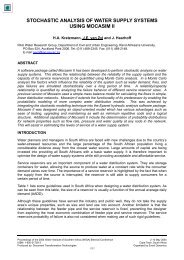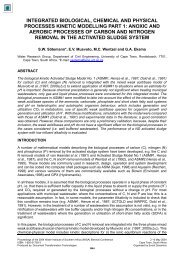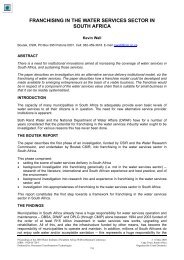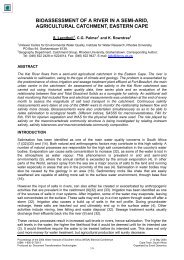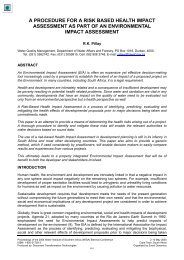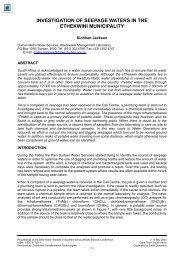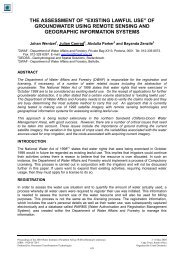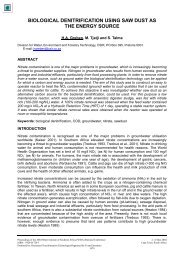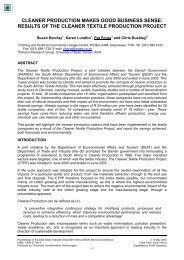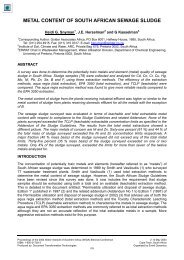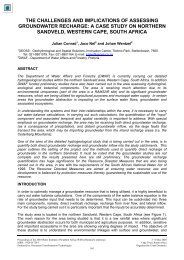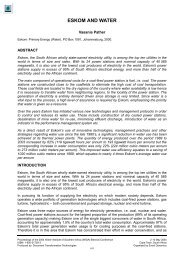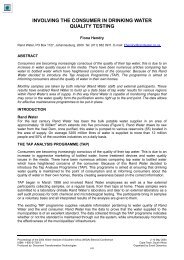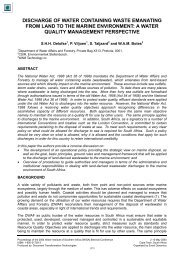Olufayo O.A , F.A.O Otieno And G.M.M Ochieng - eWISA
Olufayo O.A , F.A.O Otieno And G.M.M Ochieng - eWISA
Olufayo O.A , F.A.O Otieno And G.M.M Ochieng - eWISA
Create successful ePaper yourself
Turn your PDF publications into a flip-book with our unique Google optimized e-Paper software.
ASSESSMENT OF SAND RESERVOIR WATER STORAGE<br />
(SRWS) USING RAINFALL ANALYSIS AT DIFFERENT<br />
EPISODIC DRY DAY THRESHOLDS<br />
O.A <strong>Olufayo</strong>*, F.A.O <strong>Otieno</strong> ** and G.M.M <strong>Ochieng</strong>***<br />
*Department of Civil Engineering, Tshwane University of Technology, Private Bag X680,<br />
Pretoria 0001, South Africa, Tel.: 0123824434; e-mail: olufayooa@tut.ac.za<br />
**Faculty of Engineering and the Built Environment, Tshwane University of Technology<br />
*** Department of Civil Engineering, Tshwane University of Technology<br />
ABSTRACT<br />
Water from sand reservoir water storage for domestic and agricultural purpose needs good<br />
understanding of complex event of rainfall and its inherent characteristics. Thus simple<br />
direct method approach of calculating likelihood of event was used for assessment of<br />
water availability in sand reservoir water storage (SRWS) for Limpopo province. This gives<br />
an idea of available water in sand reservoir water storage. 30 years daily rainfall were<br />
used for analysis at different dry day threshold values of 1-,2-,3-,4-,5-, and >5days. At<br />
threshold value of >5day dry lengths the March through November match critical periods in<br />
SRWS where groundwater level recedes because of increasing chance of >5day dry<br />
lengths with continual water abstraction. It is peaked in July at over 90% chances of dry<br />
days. All these have various implications in SRWS and can be used in advising stepping<br />
construction of sand water storage barrier and buffer against climate variability and<br />
associated droughts or floods<br />
Keyword: sand water storage; rainfall; thresholds; SRWS<br />
INTRODUCTION<br />
Water from sand river beds are renewable natural water bodies. Abstraction of water from<br />
sand river beds at the rates higher than its recharge has been a problem of receding<br />
groundwater level in sand water reservoir areas. However, to ensure sustainability in sand<br />
water reservoirs assessment of water availability is therefore essential. Several methods<br />
have been adopted in assessing subsurface water storage (10, 11, 12, and 16). None<br />
address issues of water availability towards episodic dry day lengths. This holds especially<br />
for semi arid Limpopo Province of South Africa which is attributed to the vagaries of rainfall<br />
and episodic dry length frequencies. Streamflow data may provide a clue of water<br />
availability in subsurface water storage but not always available at location of interest for<br />
analysis and often rainfall event-based methods used (17). For rainfall event-based,<br />
understanding and predicting water availability in SRWS may need long-term historical<br />
reconstructions and projections of rainfall records. Using historical statistical tool, the risk<br />
or chance of water availability in SRWS in certain weather trends such as dry days of<br />
certain durations during particular month can be assessed.<br />
The erosion and deposition in rivers and streams are determined by the hysteretic<br />
between discharge and yield of sediments depending on rainfall and its runoff (22), and<br />
these influence SRWS. Therefore, when making SRWS development plans, it is important
to understand the characteristics of rainfall. Rainfall impact directly on sediment transport<br />
capacities of the surface runoff as the grain size of the sediments is dependent on river<br />
flow velocity. The quality of the sediments deposited determines the storage capacities of<br />
SRWS as this form the aquifer for water storage. Therefore, there is a need for analysis of<br />
inherent nonoccurrence of rainfall to assess likelihood of water availability in SWRSS.<br />
The main objective of this study is thus to provide a tool for assessing SRWS at any<br />
particular period of the year by using rainfall analysis.<br />
WATER AVAILABILITY<br />
Water from the sand reservoir water storage (SRWS) depends on recharge from rainfall<br />
and percolation from runoff. Runoff can be magnified significantly by the effect of climate<br />
variability on hydrological system and catchment characteristics. Ephemeral river flow is<br />
sensitive to variations in rainfall as runoff is the residual after soil moisture replenishment<br />
(13). However, for semi-arid regions where rainfall is limited and erratic the water<br />
availability in SRWS needs to be appraised to assess the recharge capacities of the<br />
hydrogeological formations. Water can be assessed with non-committed runoff flowing<br />
unutilised. This can be achieved by analysing rainfall under different episodic dry day<br />
thresholds. The variations in rainfall trend in space and time, and its relevance on the<br />
scope of artificial recharge to subsurface reservoirs can be considered for assessing the<br />
surplus surface water availability (18).<br />
HYDROLOGY OF SAND WATER STORAGE<br />
Erratic patterns of rainfall combined with different rain and dry periods, as found in arid<br />
(semi) arid regions, has increased the incidence of ephemeral streams (20). This holds<br />
especially in the northern region of South Africa. Ephemeral stream is a stream that flows<br />
only for short periods in direct response to precipitation. Usually, ephemeral stream<br />
experience heavy water runoff for short periods of time after rain which can be several<br />
metres high. During such periods of high flow, large amount of sediments are washed<br />
downstream and water stored in deposited sediments. However, when impermeable layer<br />
sealed off leakages of water from deposited sands. Water is retained to form an aquifer<br />
that can provide clean water lasting through dry periods. Thus such water from sand river<br />
form an important groundwater source (7) for rural and semi arid areas of South Africa and<br />
often the only dependable water source in some rural areas.<br />
South Africa is not water rich and among the driest countries in the world (14). Surface and<br />
groundwater have been reported to be relatively scarce because of sparsely events of<br />
rainfall. However, groundwater is often considered dependable source of freshwater in arid<br />
and semi arid zones because of its ability to regenerates (6) and is a source of supply to<br />
many users in rural communities. South Africa hard rock geology further constrained<br />
availability of groundwater (8) and recharge is often limited to rainfall causing the<br />
intermittent flow in dry river sand beds.<br />
(9) observed hydrological process in arid areas such as South Africa differs substantially<br />
from humid environments. Surface runoff in arid environments occurs during short periods<br />
of heavy precipitation (4). The ponding point for infiltration is reached within 10mins of first<br />
rain and overland flows forms the major part of the basin runoff (3) carrying much<br />
sediments load. Although, it is probable that reservoirs can be developed to capture water,<br />
but they are vulnerable to loss of water through evaporation (4) and surfer severe siltation<br />
problems. However, Sand water storage stores water runoff in sediments eliminating
problems of siltation and evaporation. A subsurface reservoir created this way holds water<br />
during wet season and used throughout the dry season (5). Because water is stored under<br />
the ground; contaminations and submergence of land are avoided and land above can be<br />
used.<br />
MATERIALS AND METHODS<br />
Polokwane formerly known as Pertersburg was selected for the study area. A typical<br />
characteristic of the rainfall regime in the study area is a long dry period during the<br />
summer. Polokwane is situated on latitude 23 0 56’ S and longitude 29 0 23’ with elevation of<br />
1284m (16). Thus, it is found in the central part of the Limpopo province with mean annual<br />
rainfall of 478 mm per annum. The intensity of rainfall varies between the rainy and nonrainy<br />
seasons by 11mm and 7mm (1). The average annual air temperature range from<br />
12,2 0 C in June/ July to 22,6 0 C in January (19).It is known as one of the driest areas in<br />
South Africa (15) with several scattered rural settlements. Figure 1 shows the map of<br />
Limpopo Province.<br />
Figure 1. Map of Limpopo Province South Africa<br />
30 years records (1978-2007) of daily rainfall occurrence totalling 10 957days were<br />
collected from South African Weather Services. A long period of record is one of the needs<br />
for frequency analysis. The data were generated from rainfall measurement using<br />
standard rain gauge. The records of rainfall are taken and entered against the day<br />
preceding that on which they were read. Computer codes were written in MATLAB for<br />
analysis of the data. In analysing the data, direct approach using simple arithmetic and<br />
elementary statistical methods were used. This was used so the results can easily appeal<br />
to users and interpreted by non-professional and allowing flexibilities to adapt to any other<br />
water resources problems in the area.<br />
Total frequency of occurrence of specific threshold of Dd<br />
Relative frequency (%) = X 100 [1]<br />
Total number of days in the month
Table 1. Calculated probability of occurrence of various thresholds of dry days<br />
Dry<br />
day(Dd) Jan Feb Mar Apr May Jun Jul Aug Sep Oct Nov Dec<br />
1 0.21 0.22 0.17 0.19 0.05 0.04 0.02 0.02 0.11 0.14 0.28 0.33<br />
2 0.17 0.14 0.10 0.06 0.04 0.03 0.03 0.01 0.07 0.11 0.19 0.13<br />
3 0.10 0.09 0.18 0.07 0.05 0.04 0.01 0.03 0.05 0.14 0.07 0.10<br />
4 0.09 0.10 0.09 0.08 0.04 0.01 0.03 0.04 0.04 0.08 0.13 0.10<br />
5 0.05 0.12 0.06 0.05 0.04 0.02 0.01 0.04 0.02 0.11 0.08 0.11<br />
>5 0.37 0.33 0.39 0.55 0.77 0.86 0.92 0.88 0.71 0.42 0.25 0.23<br />
RESULTS AND DISCUSSION<br />
Ten thousand nine hundred and fifty-seven (10, 957) run of daily rainfall records were<br />
processed with MATLAB for use in the SRWS assessment. The probabilities are<br />
calculated at six different threshold levels of dry days of 1-,2-,3-,4-,5-and >5 days. The<br />
thresholds were chosen to enable user to decide on the suitable dry days sufficient for<br />
assessment. Dry day lengths and water abstraction yield the product of receding<br />
groundwater level at all-time without recharged from rainfall. This holds especially for<br />
Limpopo Province in which ephemeral sand river channel is prevalent (1). Table 1 shows<br />
the computed probabilities of dry days while figure 2 shows the graphical representations<br />
of the probability distribution at various thresholds of dry day lengths.
1-day dry length represented intermittent periods of rainfall. It can be shown in figure 2 that<br />
sediment transport and higher concentration of sediment will agree more to the periods<br />
from September through December to around May because of the rising limb of 1 dry day.<br />
This is peaked in December with a value of 33% and minimum in August with a value of<br />
2%. On the other hand, same can be said for thresholds of 2-, 3-, 4-, and 5days which all<br />
have their rising limbs in September and declined around May. The results agree with (1)<br />
who found the period October to March receiving 86% of the rainfall, while 50% occurring<br />
from November to January. The winter months June to August receive only 2% of rainfall.<br />
Studies have pointed out that sediment-rating curve is positively correlated between the<br />
sediment load and the water discharge (21). The suspended sediment load is generally<br />
higher in the rising limb of any flood hydrograph compared with the recession limb (1).<br />
Theoretically this infers that groundwater level will be raised as deposited sand stored<br />
more water in SRWS. The highest expected periods are December and February with<br />
values of 33% and 22% respectively. At threshold of >5 days the March through November<br />
match to critical periods in SRWS (1) where it is expected that groundwater will be<br />
reduced because of increasing prolonged dry days. Maintenance can be scheduled<br />
around this period as well as phased increment of height of barrier if the reservoir has<br />
been fully silted up.<br />
CONLUSION<br />
It is fundamental to be sure of availability of source of water for recharging purposes in<br />
SRWS and planning must include hydrological analysis. Although SRWS are site specific<br />
and thus similar areas are to be based on local environmental characteristics.<br />
The component of rainfall, dry length frequency, has been analysed and the probability of<br />
occurrence established in other to assessed SRWS. The February to November match the<br />
periods of high probability of greater than 5 dry days. This represents the declining periods<br />
of groundwater level because of limited opportunity to be recharged by rainfall/ runoff with<br />
a continual abstraction of water from sand and localized leakages. SRWS periodic<br />
maintenance can be scheduled to match this period. Increment of dam heights can be<br />
done these periods in a silted up reservoir.<br />
ACKNOWLEDGMENT<br />
Authors thank Tshwane University of Technology for sponsorship and financial support for<br />
the ongoing research.<br />
REFERENCES<br />
1. M.L Hugo and P.S Hattingh, “An Analysis of Bed Material in Ephemeral Streams of<br />
South Africa”, Zeitschrift für Geomorphologie, Vol. 12 p.191, (1971)<br />
2. A. Islam and A. Kumar, A program for frequency analysis of rainfall data, IE (1)<br />
Journal – AG Vol. 84, p.1 (2003)<br />
3. I. Reid and L.E. Frostick, Flow dynamics and suspended sediment properties in arid<br />
flash floods, Journal of Hydrological Processes, Vol. 1, p 239 (1987)<br />
4. J. Aerts, R. Lasage, W. Beets, Hans de Moel, G. Mutiso, S. Mutiso and Arjen de<br />
Vries, Robustness of sand storage dams under climate change. Vadose Zone<br />
Journal, Vol. 6 No.3 p 572 (2007)<br />
5. H. Onder and M.Yilmaz, Underground dams a tool of sustainable development and<br />
management of groundwater resources. European Water Vol.11/12, p 35 (2005)
6. M.E. Al-ahmadi, A.A El-fiky, “Hydrological evaluation of shallow alluvial aquifer of<br />
Wadi Marwani, Western Saudi Arabia”, Journal of King Saud University- Science,<br />
doi. 10.1016/j.jksus.2009.10.005 (2009)<br />
7. O.A. <strong>Olufayo</strong>, F.A.O. <strong>Otieno</strong> and G.M. <strong>Ochieng</strong>, Run-off storage in sand reservoirs<br />
as an alternative source of water supply for rural and semi arid areas of South<br />
Africa. WASET Vol. 56, pg 547 (2009)<br />
8. Department of Forestry and Water Affairs, National Water Resources Strategy<br />
DWFA (2004)<br />
9. Yie-Ruey Chen, Shun-Chieh Hsieh, Jing-Wen Chen and Yiwen Hui, Assessment of<br />
rainfall-induced sediment disasters due to sloping field development, Proc. 19 th Int’l<br />
offshore and Polar Engineering conference, p 21(2009)<br />
10. M. Ertsen and R. Hut, Two waterfalls do not hear each other, sand –storage dams,<br />
science and sustainable development in Kenya, J. Phys. Chem. Earth,<br />
doi:10.1016/j.pce.2008.03.009 (2009)<br />
11. D.E Wallace and D.P Spangler, Estimating storage capacity in deep alluvium by<br />
gravity-seismic methods, Bulletin of the Int’l Assoc. of Scientific Hydrology, Vol.15<br />
No.2 p91 (1970)<br />
12. R. O. Quilis, M. Hoogmoed, M. Ertsen, Jan Willem Foppen, R. Hut, Arjen de Vries,<br />
Measuring and Modelling hydrological processes of sand-storage dams on different<br />
spatial scales, J. Phys. Chem. Earth, (2008)<br />
13. L. Oyebande, Water problems in Africa-how can the science help?, J. Hydrological<br />
Sciences Vol. 46(6) p947 (2001)<br />
14. P. Mukheibir and D, Sparks, Climate variability, climate change and water<br />
resources strategies for small municipalities. Water Research Commission, WRC<br />
Report No. 1500/1/06, (2006)<br />
15. C.L Machethe, N.M Mollel, K. Ayisi, M.B Mashatola, F.D.K Anim, and F. Vanasche,<br />
Smallholder agricultural development in the Olifants River Basin of Limpopo<br />
Province: Management Transfer, Productivity, Profitability and food security issues,<br />
Water Research Commission, WRC Report No. 1050/1/04(2004).<br />
16. J.B Stall, An analysis of water availability in semiarid zones, Proc. of the Canberra<br />
Symposium: IAHS-AISH Pub. No. 128 p 191(1979)<br />
17. J.C. Smithers and R.E. Schulze, Design rainfall and flood estimation in South<br />
Africa, Water Research Commission, WRC Project No. K5/1060 (2002)<br />
18. Ministry of Water Resources New Delhi, Guide on artificial recharge to groundwater,<br />
Central Ground water Board (2000)<br />
19. Peter Iligner, Environmental assessment report for the proposed Matimba-Witkop<br />
No2 400KV Transmission line, Limpopo Province, Specialised study –Geohazards<br />
(2004)<br />
20. C. Gijsbertsen, A study to up-scaling the principle and sediment (transport)<br />
processes behind sand storage dams, Kitui District, Kenya. Master thesis<br />
Hydrolgeology, Verije University Amsterdam (2007)<br />
21. Zhang Jian-chun and Shi Zhi, “Relation between precipitation In Dabie mountain<br />
watershed and sediment transport in Dasha river valley”. Proc.of 13 th International<br />
Soil Conservation Organisation Conference – Brisbane, July (2004)
22. T.Shimada and K.MIYAMOTO, Correlation analysis of rainfall: classification method<br />
of rainfall in view of sediment yield and transport, Proceedings of the Yokohama<br />
Symposium, IAHS Publ. no. 217, July (1993).



